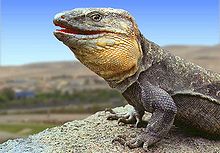Canary lizards
| Canary lizards | ||||||||||||
|---|---|---|---|---|---|---|---|---|---|---|---|---|

Small Canary Lizard ( Gallotia caesaris ) |
||||||||||||
| Systematics | ||||||||||||
|
||||||||||||
| Scientific name | ||||||||||||
| Gallotia | ||||||||||||
| Boulenger , 1916 |
The Canary lizards ( Gallotia ) are endemic to the Canary Islands . For real lizards (Lacertidae), the representatives of this genus have relatively wide skulls and also differ from their relatives in details of the scales.


species
- Eastern Canary Lizard ( Gallotia atlantica )
- La Palma giant lizard ( Gallotia auaritae )
- La Gomera giant lizard ( Gallotia bravoana )
- Small Canary Lizard ( Gallotia caesaris )
- Canary Island Lizard ( Gallotia galloti )
- Tenerife giant lizard ( Gallotia intermedia )
- El Hierro Giant Lizard ( Gallotia simonyi )
- Gran Canaria Giant Lizard ( Gallotiastehlini )
- † Gallotia goliath
nutrition
Canary Islands lizards eat a lot of plant-based food in addition to the insect food common to all lizards. In doing so, they do not spare humans' crops and eat z. B. tomatoes or grapes. That is why farmers fight them with poison and traps.
Giant growth
On Gran Canaria , Tenerife , La Gomera and El Hierro, there are huge endemic Canary Islands lizards. The phenomenon called gigantism often occurs in island forms of lizards and rodents . Island populations tend to develop significantly larger body shapes than on the mainland. The Gran Canaria giant lizard grows to around 40 to 50 centimeters long, while the El Hierro giant lizard can grow up to 75 centimeters long.
While the Gran Canaria giant lizard is still very common and was also released by humans on Fuerteventura , the La Gomera giant lizard and the El Hierro giant lizard were already considered extinct. In the 1970s, a goatherd discovered a residual population of the animals on El Hierro. In June 1996 a biologist discovered giant lizards in the Teno Mountains on Tenerife. There is a population of 300 to 500 animals. In 1999 some giant lizards were discovered on a steep face in the Valle Gran Rey on La Gomera . Seven specimens were caught with traps and are propagated in an outdoor terrarium in the south of La Gomera.
In December 2007 a photo came into circulation, which is supposed to show a specimen of the La Palma giant lizard, which was previously regarded as extinct and otherwise known only from subfossil bone material. However, this assignment was also disputed by experts and, since no new confirmations have become known since then, it must be considered dubious.